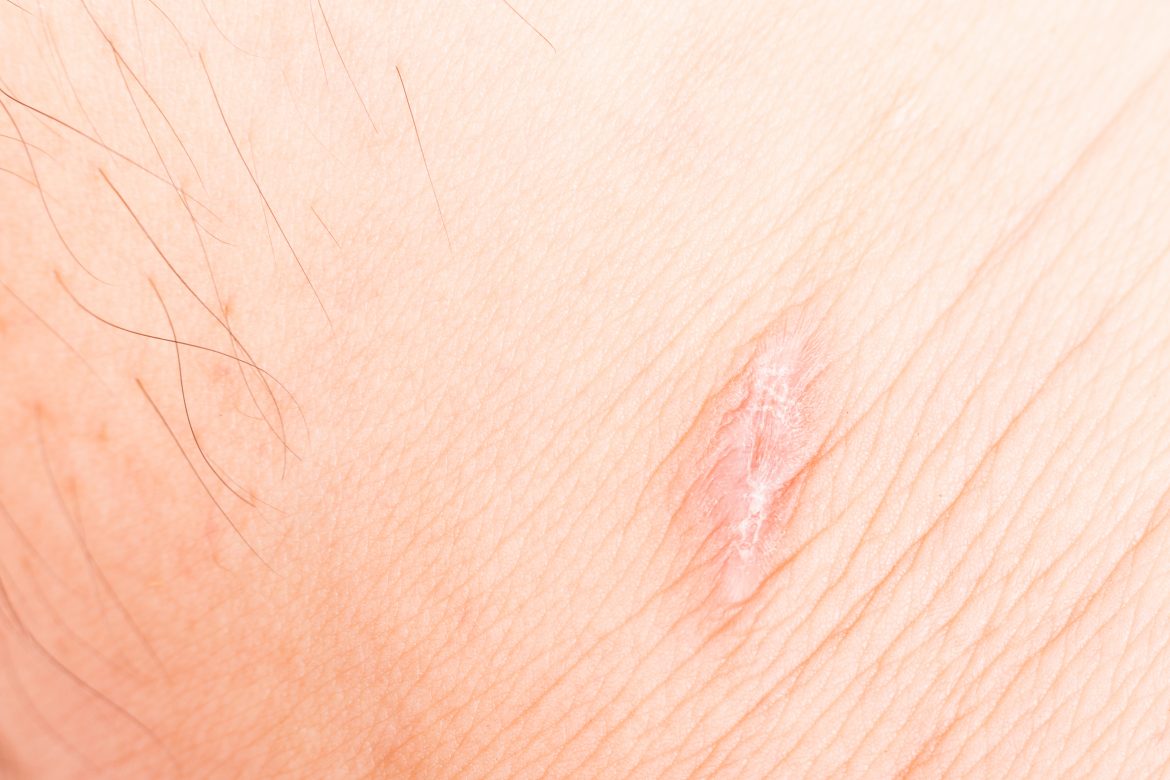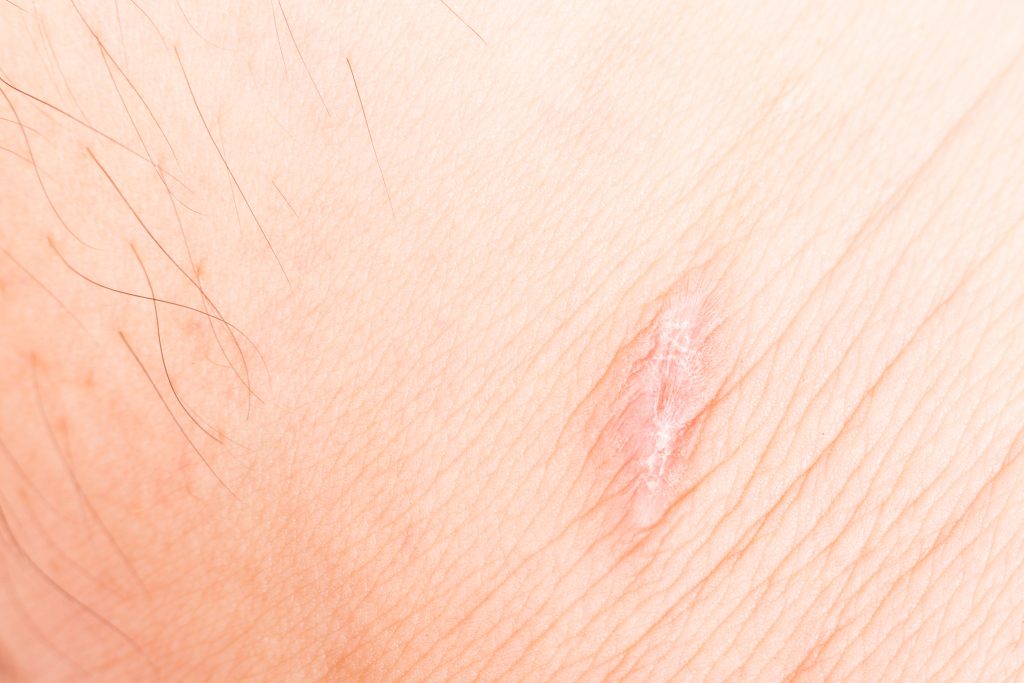
How to Reduce Scars? Tips to Reduce the Appearance of a Scar

Recently, two people in my family got a new scar…on their face!
Having a scar is one thing, having one on your face is another! Let’s take a closer look at how the skin repairs itself after a wound and what you can do to reduce the appearance of a scar.
What Is a Scar?
After an injury, the skin must repair itself. The cells in the epidermis around the wound will stretch and join together to close the skin. Collagen, which is found in the skin, contributes to rapid healing of a wound…but it can also be harmful if it is found in excessive quantities! If there is too much collagen in the skin, it can slow down the process and leave a puffy mark where the wound occurred.
The skin is flexible whereas a scar is richer in fibers, which is why the skin looks stiffer in this area. You must act quickly if you want it to be as seamless as possible! Let’s start by understanding different types of scars.
What Are the Different Types of Scars?
Depending on the injury that caused the scar and our body’s reaction to it, scars may look very different from one another! Some injuries will create scars that look like holes in the skin, such as acne scars, while others will create visible bumps. Some types of scars will not be easily noticeable: they will be flush with the skin, but can sometimes have a different coloration.
Here are the most common types of scars:
Scars Due to Skin Problems
This type of scarring is very common in people who had acne as a teenager or chicken pox as a child. These scars look like small holes or craters: they are usually found on the face or back!
Hypertrophic Scars
Hypertrophic scars are caused by too much collagen production by the skin. This type of scar has a lot more fibrous tissue, which increases its volume and creates a bump on your skin. They can come in many different colors and sizes, but are most common on darker skin types.
Subcutaneous Scars
This type of scar is unique! It is caused by a tear in the dermis without tearing the upper skin layers: your epidermis is not affected by a subcutaneous injury. The most popular example of this type of scar is stretch marks, caused by rapid changes in the body (weight gain, growth spurt, pregnancy, etc.).
There are other types of scars which vary in size, colors and causes, such as keloid scars and surgical scars. If you have any questions about what products to use for your scars, you should consult professionals! Pravi’s experts would be happy to help you.
Do All Injuries Leave Scars?
No, not all injuries cause scarring! In order for scarring to occur, the cut or tear must reach the dermis, the lower part of the skin where the blood vessels are located. If your wound does not bleed, it is unlikely that you will have a scar!
Proper Care for the Healing Process
Take Care of Yourself During the Healing Process
Keeping your skin clean and healthy after an injury is an excellent habit to ensure rapid healing and avoid infection. The key to successful healing is to avoid creating a dry environment around the scar tissue: a moist environment promotes skin cell regeneration. It is also a great way to reduce the urge to scratch! We suggest the following tips:
- Choose a healthy diet rich in iron and zinc;
- Avoid scratching, tearing or playing with the wound;
- Clean well with soap and water (avoid peroxide) to avoid infections;
- Avoid smoking, it slows down the repair process;
- Cover your scars to avoid hyperpigmentation;
Once Your Skin Is Closed, Here Are Some Good Habits To Follow:
When it comes to scars, everything happens in the first few months of healing. It is therefore important to be proactive and not to wait: the sooner you take the right steps, the better the healing will be. You have between 6 and 12 months to act, after that it could be too late!
These simple steps and daily care can improve your chances of a good healing:
- Massage the scar: roll the scar under your fingers to soften the skin and avoid adhesions. If adhesion occurs, a physiotherapist may be able to help you.
- Protect your scar from the sun: Protect your scar from the sun while it is still red or pink. Proper sun protection will prevent it from permanently darkening.
- Keep your skin well hydrated: Moisturize your skin with vegetable oil such as argan or rose hip. These oils are both rich in vitamin E and are excellent skin regenerators.
How To Reduce Scars Naturally?
Let’s face it, some scars are very difficult to minimize. A subcutaneous scar or a hypertrophic scar that you have had for years and whose appearance does not change is likely to remain. However, by acting quickly with the right products, it is possible to reduce your scars naturally!
Essential Oils
One of the best known natural solutions is essential oils added to vegetable oils. They are an excellent way to reduce scars, both on your face and on your body. They moisturize and penetrate the skin deeply, creating the perfect conditions for a beautiful healing! Be careful not to confuse them with mineral oils, which do not have the same effect and should be avoided.
Italian Helichrysum Essential Oil: a Pravi favorite
Italian Helichrysum essential oil is your best ally when it comes to soothing a scar or a hematoma! This essential oil has powerful healing and antifungal properties. Apply one drop 3 times a day by massaging the area until complete healing. This essential oil is a must-have for the whole family!
We always recommend that you do a patch test before you start using Italian Helichrysum! It should also be avoided during pregnancy and breastfeeding.
Lavender: An Essential Oil with a Thousand Virtues!
It has healing, anti-inflammatory and antiseptic properties, and is also soothing and calming for the skin and the mind! It is probably the best known and most used essential oil! Its properties promote the regeneration of skin tissue and soothe itching associated with scars. Having a small bottle on hand will help you in many ways and has no contraindications.
Make Your Own Essential Oil Blend for Your Scars!
Want to make a homemade concoction? In a 15 ml bottle, mix 6 ml of argan or rosehip vegetable oil with 25 drops of Italian helichrysum essential oil and 25 drops of True lavender essential oil (make sure to use organic ingredients!). Apply 1 to 2 drops 2 to 3 times a day for 10 days on a fresh scar and longer for an older scar.
*These tips do not substitute for a doctor’s advice.


Leave a Reply